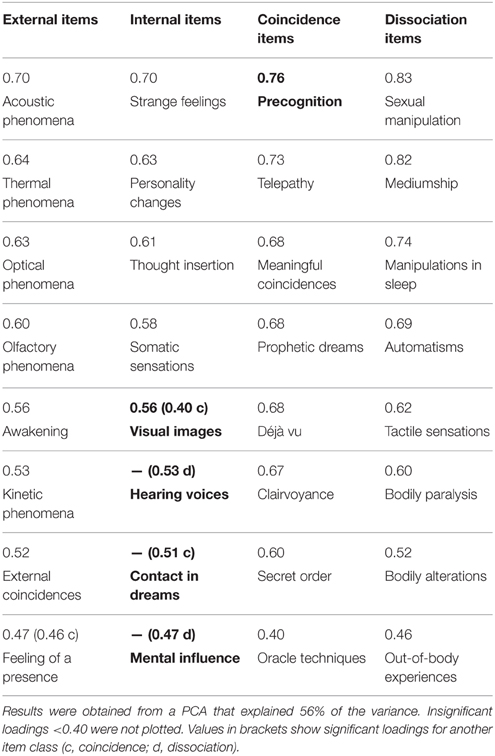
95% of researchers rate our articles as excellent or good
Learn more about the work of our research integrity team to safeguard the quality of each article we publish.
Find out more
GENERAL COMMENTARY article
Front. Psychol. , 25 September 2015
Sec. Psychology for Clinical Settings
Volume 6 - 2015 | https://doi.org/10.3389/fpsyg.2015.01414
This article is a commentary on:
A Comparative Study of Exceptional Experiences of Clients Seeking Advice and of Subjects in an Ordinary Population
A corrigendum on
A comparative study of exceptional experiences of clients seeking advice and of subjects in an ordinary population
by Fach, W., Atmanspacher, H., Landolt, K., Wyss, T., and Rössler, W. (2013). Front. Psychology 4:65. doi: 10.3389/fpsyg.2013.00065
In the article published in Frontiers in Psychology 4, February 2013, article 65, a few entries in Tables 2–4 have been misprinted. The corrected entries are highlighted bold in Tables 2–4 below. The errors in Tables 2, 3 were due to mistaken data import from SPSS into the submitted manuscript. The erroneous positions of entries in Table 4 were due to misprints from the submitted manuscript during copy-editing, and we missed them in the proofs.

Table 2. Loading values ≥0.40 for the 32 variables in the 4 basic classes of EE for subsample II (IGPP follow-up, N = 176).

Table 3. Loading values ≥0.40 for the 32 variables in the 4 basic EE classes for subsample III (Swiss online, N = 1352).
The corrected result under internal items in Table 2 shows that “contact in dreams” actually loads under coincidence experiences. This entails a slightly weaker significance of the distinction into basic EE classes for subsample II than in the original publication. The corrected results under internal items in Table 3 move the loadings for the lowest three items to dissociation and coincidence experiences, thus again reducing the significance of the distinctions between classes for subsample III as compared to the original publication. The conclusions of the article remain unchanged.
The construction of the four basic classes from the distinction between self model and world model implies that a perfect distinction between classes cannot be expected anyway. The reason is that the relational classes (coincidence, dissociation) are by definition not independent of the classes (internal, external) between which they are relations. Only in case of full independence could a standard PCA resolve classes perfectly.
Finally, the size of sample III (Swiss online) has been misprinted as N = 1532 on p. 4 (right column, third paragraph, line 6) and in Table 5 (caption). The correct sample size is N = 1352.
The authors declare that the research was conducted in the absence of any commercial or financial relationships that could be construed as a potential conflict of interest.
We are grateful to Lui Unterassner for indicating some of the misprints corrected here.
The original article has been updated.
Keywords: continuum hypothesis, exceptional experiences, mental disorders, phenomenological patterns, mental health services
Citation: Fach W, Atmanspacher H, Landolt K, Wyss T and Rössler W (2015) Corrigendum: A comparative study of exceptional experiences of clients seeking advice and of subjects in an ordinary population. Front. Psychol. 6:1414. doi: 10.3389/fpsyg.2015.01414
Received: 24 March 2015; Accepted: 04 September 2015;
Published: 25 September 2015.
Edited and reviewed by: Francesco Pagnini, Catholic University of Milan, Italy
Copyright © 2015 Fach, Atmanspacher, Landolt, Wyss and Rössler. This is an open-access article distributed under the terms of the Creative Commons Attribution License (CC BY). The use, distribution or reproduction in other forums is permitted, provided the original author(s) or licensor are credited and that the original publication in this journal is cited, in accordance with accepted academic practice. No use, distribution or reproduction is permitted which does not comply with these terms.
*Correspondence: H. Atmanspacher,YXRtYW5zcGFjaGVyQGNvbGxlZ2l1bS5ldGh6LmNo
Disclaimer: All claims expressed in this article are solely those of the authors and do not necessarily represent those of their affiliated organizations, or those of the publisher, the editors and the reviewers. Any product that may be evaluated in this article or claim that may be made by its manufacturer is not guaranteed or endorsed by the publisher.
Research integrity at Frontiers

Learn more about the work of our research integrity team to safeguard the quality of each article we publish.